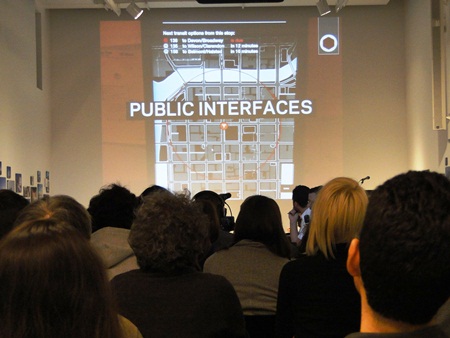by: admin

Adam Greenfield, Founder of Urbanscale, discusses Urbanflow.
Daniel Fox
Event: RE:Think – Design Thinking Outputs
Location: Center for Architecture, 04.12.12
Panelists: Troy Therrien, Partner, Th-ey and Curator at Experiments in Motion, Columbia University, New York; Adam Greenfield, Founder, Urbanscale; Ken Farmer, DoTank Brooklyn; Landon Brown, Director of VisionArc; Georgeen Theodore, Partner, Interboro Partners; David Benjamin, Principal, The Living
Moderator: Chris Leong, Partner at Leong Leong
Organizer: AIANY New Practices Committee
Media Sponsorship for New Practices’ 2012 programming provided by The Architect’s Newspaper.
I had always associated think tanks with the government, especially the military. A panel of eight energetic young architects set out to refresh the concept, each rebranding “think tank” in the context of small architectural practices searching for a way to combine thinking, planning, and strategy with action.
How many people does it take to form an architectural think tank? For Troy Therrien of Th-ey, it can start with two. But Therrien’s presentation of a history of think tanks, one that focused on freedom of exchange instead of control by knowledge, ensured that the results of an incubation period will affect—and be affected—by many individuals. For Ken Farmer of DoTank, the number of people in a think tank is different every time. Working with an ever-changing set of clients and colleagues, Farmer’s bottom-up approach to the organization and dissemination of knowledge gives his think tank process freedom from agenda. While the “incubator rises out of market forces,” WHOWNSPACE, a project related to DoTank, can push against them by calling attention to the rights of New York City residents in public spaces.
Georgeen Theodore described projects by her firm Interboro Partners, which is continuously “working within the constraint of the city, and working against it,” as looking for “spontaneous urban moves.” Interboro’s 2011 project “Holding Pattern” for the Young Architects Program at PS1, for example, used the “Robin Hood” design method. They created objects that could be re-used outside the walls of the museum: in a nearby taxi cab company’s offices, senior and day care centers, high schools, settlement houses, the local YMCA, a library, and a greenmarket. Landon Brown of VisionArc, a think tank dedicated to exploring the role of design and global issues, was also interested in the way that architects could “study informal resource networks.” He presented mapping and imaging projects that responded to climate, energy, and resource issues.
David Benjamin, who co-founded The Living in 2004, aligns with the concept of the think tank through an approach to technology, “not for progress or efficiency” but for experimentation itself. By far the most bottom-up design process described was Benjamin’s use of differentiating patterns in certain bacteria’s genetic make-up to inform design. On a completely different, but comparably complex scale, Adam Greenfield presented Urbanflow, an “operating system for cities” recently deployed in Helsinki.
For many of the panelists, dissatisfaction with traditional practice methods compelled them to find new avenues for working with corporations and institutions. If think tanks are the new smart start-ups of architectural practice, they threaten the future of top-down Starchitecture.
Greta Hansen is a New York-based architectural designer and writer.









